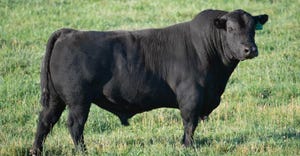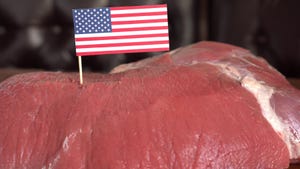Prices Drop Amid Uncertainty
“Tightness of cattle inventories at all levels is increasing the volatility in cattle and beef prices,” explain Economic Research Service (ERS) analysts in their monthly Livestock, Dairy and Poultry Outlook (LDPO) issued last week.
March 20, 2011

“Tightness of cattle inventories at all levels is increasing the volatility in cattle and beef prices,” explain Economic Research Service (ERS) analysts in their monthly Livestock, Dairy and Poultry Outlook (LDPO) issued last week.
That’s because every move outside of normal is magnified. It can be something as visible as last week’s calamity in Japan (see “Japanese Calamity Jolts Markets”), or it can be as insidious as pulling more cattle forward to the feedlot in deference to wheat-pasture grazing that never materialized or was shortened by poor growing conditions.
Consider last week’s trade of feeders that began the week higher and then ended $2-$5 lower.
Consider fed cattle. Though limit-down moves in the futures markets, in response to uncertainty surrounding events in Japan, took $3-$5 out of the live fed-cattle market, boxed-beef cutout values never missed a beat. Choice boxed-beef cutout value ($187.51) closed $6.05 higher than the previous week. Select cutout ($185.49) closed $5.61 higher.
Calves were less affected, trading unevenly steady to firm; as much as $5 higher on a scattered basis for calves that could head to grass.
“The expanding dry conditions in the Southern U.S. are causing pastures to deteriorate and dimming prospects for a wheat crop,” say ERS analysts. “According to some experts, sufficient precipitation could salvage the wheat crop. However, others think that it is already too late and that the crop is in too poor a condition for even that prospect. The dryness does raise the potential for some limited graze-out wheat pasture. If some wheat is grazed out, some feeder cattle could be placed in feedlots in late April-May. Otherwise, these cattle will move into summer grazing programs in areas where adequate forage is available.”
Looking a touch further down the road, ERS analysts explain that, “Despite a 39% year-over-year decline in cumulative year-to-date imports of cows from Canada for slaughter, total weekly federally inspected cow slaughter is up about 3% over year-earlier slaughter on a cumulative weekly slaughter basis through Feb. 26, 2011. Dairy-cow slaughter, up 11%, has continued unabated, and because dairy cows hang heavier carcasses than beef cows, is adding to average dressed weights for cows. Beef-cow slaughter, on the other hand, has declined more than 4% from year-earlier cumulative totals. As Southern pastures continue to deteriorate from the lack of precipitation and as cow prices continue to provide incentive to sell cows, the potential for further removal of cows from the area increases.”
At the same time, cattle-feeding margins continue to deteriorate. According to the most recent Kansas State University “Focus on Feedlots” analysis, costs of gain (COG) for steers and heifers sold in January were the highest since August 2008. Average COG for steers was $94/cwt., $19/cwt. more than the previous year. Average COG for heifers was $100/cwt. compared to $77.50/cwt. in 2010. This analysis pegs the average COG for this year at a record-high $102-$110/cwt.
The ERS analysts also explain, “…current equity requirements and financial commitments for cattle feeding are at record highs. Other uncertainties abound – the macroeconomic situation, ethanol and farm policy with respect to feed grains, and exports and exchange rates, to mention a few. This combination of risk factors may dampen the expectation of future profits that would motivate herd rebuilding in the context of conventional cattle feeding.”
As the AMS folks put it Friday, “The recent regularity of natural disasters has made them as much of an economic risk to agriculture producers as sharp swings in supply or demand, with absolutely no way to anticipate them. Throughout the current run of historic cattle market records, producers have been on the lookout for which factor would come out of left field to spoil the profit party. A combination earthquake/tsunami/nuclear scare was probably near the bottom of the list when it came to cattle market concerns…”
The summary below reflects the week ended March 18 for Medium and Large 1 – 500- to 550-lb., 600- to 650-lb. (calves), and 700- to 750-lb. feeder heifers and steers (unless otherwise noted). The list is arranged in descending order by auction volume and represents sales reported in the weekly USDA National Feeder and Stocker Cattle Summary:
Summary Table |
State |
Calf Weight |
OK |
MO |
Dakotas |
TX |
NE |
KY* |
KS |
IA |
AR |
AL |
CO |
WY |
Carolinas* |
GA*** |
TN* |
NM |
MT |
MS* |
FL* |
VA |
WA |
* Plus #2
** None reported of the same quality at this weight or near weight
(***) Steers and bulls
(?) As reported, but questionable
NDNo Description
1500-600 lbs.
2550-600 lbs.
3600-700 lbs.
4650-700 lbs.
5700-800 lbs.
6750-800 lbs.
7800-850 lbs.
8850-900 lbs.
You May Also Like

.png?width=300&auto=webp&quality=80&disable=upscale)

